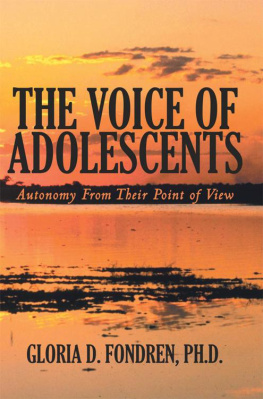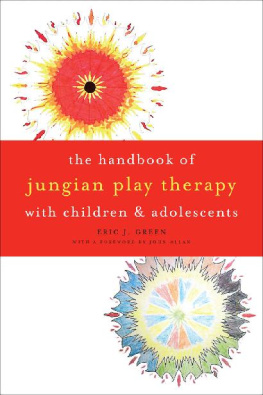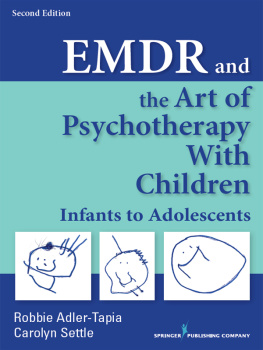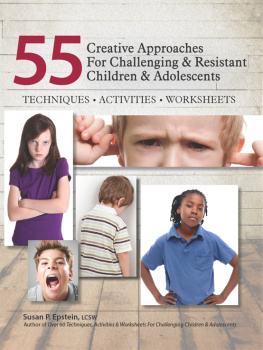Play Therapy with
Adolescents
Play Therapy with
Adolescents
Edited by
Loretta Gallo-Lopez
and
Charles E. Schaefer

Published in the United States of America
by Jason Aronson
An imprint of Rowman & Littlefield Publishers, Inc.
A wholly owned subsidiary of
The Rowman & Littlefield Publishing Group, Inc.
4501 Forbes Boulevard, Suite 200, Lanham, Maryland 20706
www.rowmanlittlefield.com
PO Box 317
Oxford
OX2 9RU, UK
Copyright 2005 by Rowman & Littlefield Publishers, Inc.
All rights reserved. No part of this publication may be reproduced, stored in a retrieval system, or transmitted in any form or by any means, electronic, mechanical, photocopying, recording, or otherwise, without the prior permission of the publisher.
British Library Cataloguing in Publication Information Available
Library of Congress Cataloging-in-Publication Data
Play therapy with adolescents / edited by Loretta Gallo-Lopez and Charles E. Schaeffer.[2nd ed.].
p. cm.
Includes bibliographical references and index.
ISBN 978-0-7657-0339-2
1. Play therapy. 2. Adolescent psychotherapy. I. Gallo-Lopez, Loretta. II. Schaeffer, Charles E.
RJ505.P6P55 2005
615.851530835dc22 | 2004023173 |
Printed in the United States of America
 The paper used in this publication meets the minimum requirements of American National Standard for Information SciencesPermanence of Paper for Printed Library Materials, ANSI/NISO Z39.48-1992.
The paper used in this publication meets the minimum requirements of American National Standard for Information SciencesPermanence of Paper for Printed Library Materials, ANSI/NISO Z39.48-1992.
To my parents Catherine and Gus Gallo, who bravely
weathered the storms of my adolescence, and taught me
that family is lifes greatest treasure. I miss you both.
LGL
To my parents, William and Loretta Schaefer,
for their love and support.
CES
Contents
Claire Milgrom
Theresa Kestly
Evangeline Munns
Christopher J. Brown
Johanna Krout Tabin
Loretta Gallo-Lopez
Virginia Ryan and Kate Wilson
Scott Riviere
Andrew Taylor and Steven C. Abell
Dorothy Breen
Neil Cabe
Thomas M. Nelson
Lisa Rogers and Hal Pickett
Karen Snyder Badau and Giselle B. Esquivel
Berthold Berg
Preface
Many people question why anyone would choose to work with adolescents. After all, adolescents are resistant, hostile, moody, resentful, defiant, frenzied, explosive, and difficult. Most psychotherapists working with adolescents know of colleagues who avoid adolescent referrals at all cost. Yet many of us are inexplicably drawn to this population. Perhaps it is because adolescents are also challenging, fascinating, creative, evolving, impassioned, spontaneous, intense, and unpredictable. And although adolescence is often marked by turmoil and inner conflict, it is also a time of growth and self-discovery. Adolescents, at times, present an external image masked in the guise of omniscience and self-assurance. However, below the surface, they are often fearful and full of questions. Our task as mental health professionals is to get past the facade, to help our young clients to examine their fears and search for answers. How do we accomplish this task? How do we get adolescents to let us in?
Play Therapy with Adolescents, the first book to offer a complete volume of play therapy approaches specifically geared toward adolescents, seeks to provide answers to these questions. This volume of chapters, written by experts in the field of adolescent play therapy, offers readers entry into the world of adolescents to make connections and forge alliances.
Each of the sixteen chapters contained within this volume provides a wealth of practical information that professionals can easily utilize in their work with adolescents individually, in family therapy, or in groups.
invites the reader to explore a myriad of play therapy approaches. Each author provides specific guidelines and theoretical framework from such diverse orientations as sandtray therapy, filial therapy, poetry therapy, theraplay, gameplay, drama therapy, and the use of metaphor and transitional objects. Approaches range from client-centered, nondirective play therapy, to highly structured and directive, cognitive-behavioral play therapy.
addresses issues related to specific problem areas especially significant in work with adolescents. Included are strategies for working with adolescents with attachment issues, delinquency issues, aggressive behaviors, and eating disorders, as well as adolescents in foster care.
Establishing trust and building relationships are the cornerstones to effective therapy with adolescents and are common themes running through each of the chapters. Authors identify strategies and offer insight related to making that all-important connection with adolescents entering therapy. Case illustrations are included in order to provide readers with examples of the practical application of the approaches presented.
Play Therapy with Adolescents is a unique volume of work that will be an invaluable resource for professionals faced with the challenging task of working with this exciting population. We hope you find yourself inspired, encouraged, and enlightened.
Loretta Gallo-Lopez
Charles E. Schaefer
I
PLAY THERAPY APPROACHES
1
An Introduction to Play
Therapy with Adolescents
Claire Milgrom
Play therapy with adolescents is increasingly being addressed in the play therapy literature (Carroll, 1998; Cerio, 2000; Gil, 1996; Jernberg and Booth, 1999; Ray, Bratton, Rhine, and Jones, 2001; Straus, 1999). However, many referral sources, including social service personnel, do not think of referring troubled adolescents for play therapy, assuming that adolescents are too old to engage therapeutically in this manner. Indeed, many therapists would not choose this medium for working with adolescents, citing similar reasons. Adolescents themselves might view cynically the idea of participating in play activities with a therapist, because their primary developmental tasks include individuation, separation, and preparation for adult roles.
In one form or another even adults continue to play, negating the idea that adolescent developmental tasks should preclude participation in play for therapeutic purposes. Adult play behavior can be seen in their participation in sports, the arts, computer and video games, gambling, board games and card games, arts and crafts, and in their attendance of costume and theme parties. Huizinga (1955) observes that play is a cultural factor in life and that the spirit of playful competition is, as a social impulse, older than culture itself, pervading all aspects of life.
For adults, playing is frequently part of relationship building. Attending a recreational event or participating in a sport or game with other adults is often a prelude to more intimate interactions. Once a relationship is established, play for adults serves many purposes including ongoing relationship building, ongoing mutual assessment of the health of the relationship, skill development, recreation, and relaxation.
The role of play in therapy with adolescents is similar in many respects. Play by definition is generally fun, which in turn, makes it an ideal means of building relationships with many clients. This is especially true for building relationships with adolescents who might be wary of authority figures and resistant to engaging. Playing is likely to be far less threatening than working on issues verbally, especially if adolescents are not voluntary clients.
Next page









 The paper used in this publication meets the minimum requirements of American National Standard for Information SciencesPermanence of Paper for Printed Library Materials, ANSI/NISO Z39.48-1992.
The paper used in this publication meets the minimum requirements of American National Standard for Information SciencesPermanence of Paper for Printed Library Materials, ANSI/NISO Z39.48-1992.